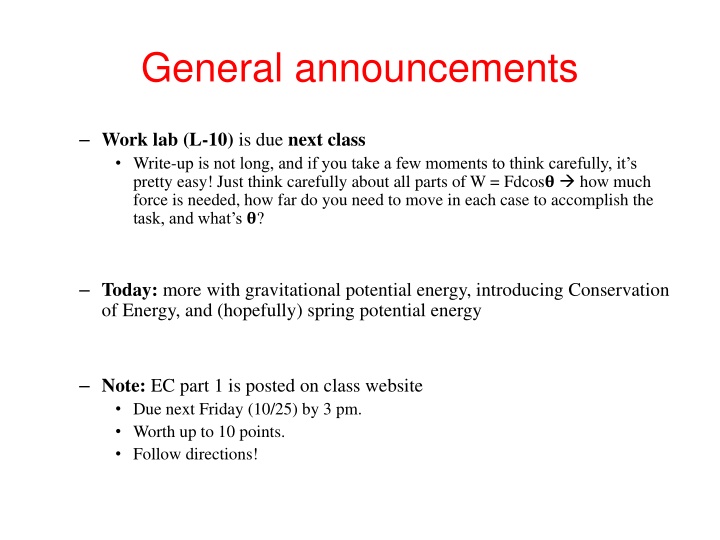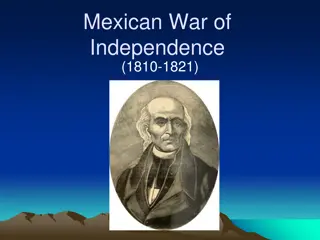
Gravitational and Spring Potential Energy in Physics
Learn about gravitational and spring potential energy, including concepts like conservative forces, spring constants, and potential energy functions. Explore how these energies relate to work, forces, and the conservation of energy in physics. Get insights on how to calculate potential energies and understand the principles behind them.
Download Presentation

Please find below an Image/Link to download the presentation.
The content on the website is provided AS IS for your information and personal use only. It may not be sold, licensed, or shared on other websites without obtaining consent from the author. If you encounter any issues during the download, it is possible that the publisher has removed the file from their server.
You are allowed to download the files provided on this website for personal or commercial use, subject to the condition that they are used lawfully. All files are the property of their respective owners.
The content on the website is provided AS IS for your information and personal use only. It may not be sold, licensed, or shared on other websites without obtaining consent from the author.
E N D
Presentation Transcript
General announcements Work lab (L-10) is due next class Write-up is not long, and if you take a few moments to think carefully, it s pretty easy! Just think carefully about all parts of W = Fdcos? how much force is needed, how far do you need to move in each case to accomplish the task, and what s ?? Today: more with gravitational potential energy, introducing Conservation of Energy, and (hopefully) spring potential energy Note: EC part 1 is posted on class website Due next Friday (10/25) by 3 pm. Worth up to 10 points. Follow directions!
Gravitational PE Near the Earth s surface, the gravitational potential energy of any object of mass m at a height y above a reference point can be found by: ? = ??? You get to decide where y = 0 is! Depending on the problem, it might be the ground, a table, the lowest point the object reaches, the highest point, whatever. It doesn t matter where y = 0 is as long as you indicate where it is, and you keep it consistent. It s the change of position that s important. Gravitational PE is also measured in Joules, just like kinetic energy and work. Gravitational PE can turn into kinetic energy and vice versa without being lost as long as there are no outside forces doing work. This is part of being a conservative force.
Springs! Attach a mass to a spring and push or pull it. It will displace a distance x from its equilibrium position, depending on the amount of force you apply. If you let go, the spring bounces back. This means the amount you pull is equal to what s called the restoring force, which (surprise, surprise) restores the spring to equilibrium. This can be represented by the equation:
Springs! In Fspring = -kx, what does the k stand for and what does it tell you? k is called the spring constant, and is unique to a given spring. A bigger k means a stiffer spring; a smaller k means a looser spring. Its units are N/m. What does the negative sign do in the expression? Does your explanation make sense for the second set-up shown below? The negative sign indicates that the restoring force applied by the spring is opposite the direction of displacement from equilibrium. If the mass in the first sketch was held in that position, would it have energy as a consequence of its contact with the spring? If so, how much?
Spring potential energy The spring, assumed to be ideal (this means it doesn t lose energy to friction as it oscillates back and forth), generates a conservative force that acts on the mass. That means the spring has a potential energy function associated with it. The whole idea behind a potential energy function is to find a function that, when evaluated at two points in the function s force field, will have a difference equal to the work done by the field as a body moves between those two points. We did this for gravity by comparing the solution of mg dotted into d to The problem with doing this with a spring is that spring forces are not constant (the more you pull a spring, the more force it applies back on you) as was gravity near the earth s surface. That means we need to use Calculus to get the job done.
Spring potential energy The approach is simple. We determine how much work is involved in moving the spring a differential (read this very small ) displacement dx, then sum up all such values between our start and finish position. So let s assume the spring starts at distance x1 from its equilibrium position, and moves to distance x2 (note that it doesn t matter which of these is larger). Using an integral sign to do the summation, this reads: ( ) Wcons. force=- U2-U1 Since , this suggests that:
Spring energy example What you are seeing below is a snapshot of a 600 gram mass attached to a spring whose spring constant k is 2.0 N/m. At t=0 seconds, the mass is moving to the left at x = -1.4 meters with a speed of 4 m/s. (A)What is total mechanical energy of the system? (B) Determine mass s speed when x = -0.2 m (C)Determine maximum distance from equilibrium (D)At what point will its kinetic and potential energy be equal?
a.) What is the total mechanical energy in the system? b.) Determine the mass s speed when at x = -0.2 meters. If we know the total energy in the system, we can use that information and the total energy expression to determine the velocity at x = -0.2 meters.
c.) Determine its maximum deflection (distance from x = 0). At maximum deflection, the body isn t moving so the kinetic energy is zero, and all the energy in the system is potential. Sooo . . . d.) At what coordinate will its potential and kinetic energy be equal? This will occur when half the 6.76 joules is wrapped up in potential energy, or:






















